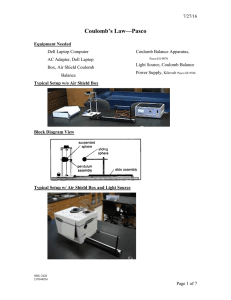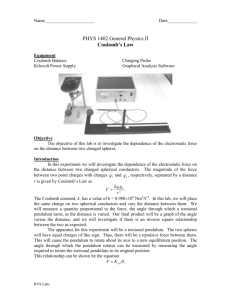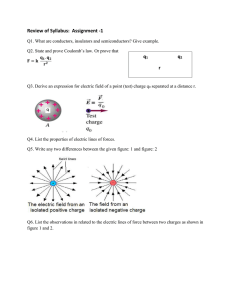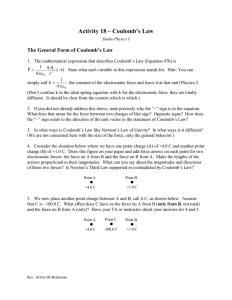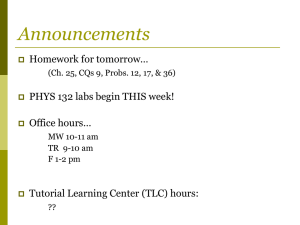Coulomb’s Law—Pasco
advertisement
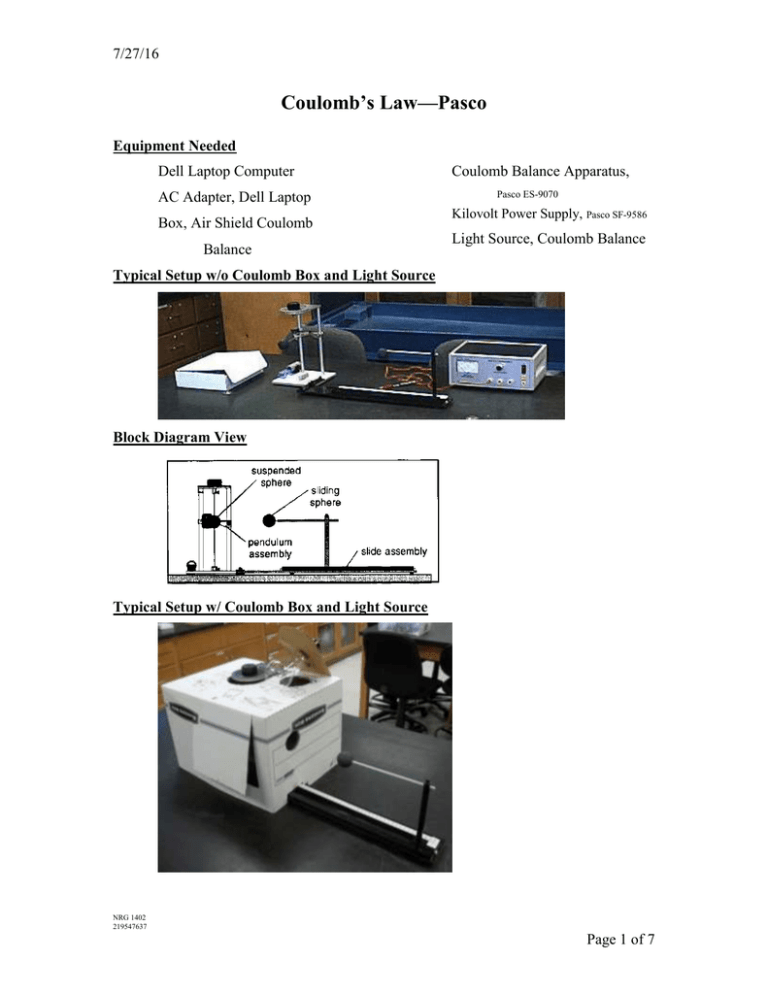
7/27/16 Coulomb’s Law—Pasco Equipment Needed Dell Laptop Computer AC Adapter, Dell Laptop Box, Air Shield Coulomb Balance Coulomb Balance Apparatus, Pasco ES-9070 Kilovolt Power Supply, Pasco SF-9586 Light Source, Coulomb Balance Typical Setup w/o Coulomb Box and Light Source Block Diagram View Typical Setup w/ Coulomb Box and Light Source NRG 1402 219547637 Page 1 of 7 7/27/16 Objective The objective of this lab is to investigate the dependence of the electrostatic force on the distance between two charged spherical conductors. Introduction In this experiment we will investigate the dependence of the electrostatic force on the distance between two charged spherical conductors. The magnitude of the force between two point charges with charges and , respectively, separated by a distance d is given by Coulomb’s Law as . The Coulomb constant, k, has a value of . In this lab, we will place the same charge on two spherical conductors and vary the distance between them. We will measure a quantity that is (almost; in the small angle approximation ) proportional to the force, the angle through which a torsional pendulum turns, as the distance is varied. Our final product will be a graph of the angle versus the distance, and we will investigate if there is an inverse square relationship between the two as expected. The apparatus for this experiment will be a torsional pendulum. The two spheres will have equal charges of like sign. Thus there will be a repulsive force between them. This will cause the pendulum to rotate about its axis to a new equilibrium position. The angle through which the pendulum rotates can be measured by measuring the angle required to return the torsional pendulum to its original position. This relationship can be shown by the equation where . This value for each Coulomb Balance Apparatus is dependent on the tension of the wire but has been found experimentally to be only slightly different from one apparatus to another. It is also time consuming and tedious to produce. Thus for NRG 1402 219547637 Page 2 of 7 7/27/16 a given deflection corrected to equilibrium you can calculate the force that created it. We know that the value of k is Coulomb’s Constant and we are going to charge the pith balls in the same manner for each distance. This will give us a constant value for on each test. With this information you can see that and . Procedure 1. Setup The Coulomb balance apparatus should already be set-up. Gently touch both of the spheres to remove any charge. If not already done, move the angle indicator to 0˚. Zero the torsional pendulum by rotating the plastic piece holding the wire on the bottom of the apparatus until the line on the counter balance pan aligns with the index mark. Move the sliding sphere to its maximum separation from the sphere attached to the torsional pendulum. Note: Check the slide calibration. This should be done before any data is taken. Move the slide to 3.8 cm. The balls should just touch at this point. (This is the center to center distance.) If this calibration is off have you instructor or the laboratory technician reset it for you. It has been set previously but can be disturbed. This is why the device numbers should match. Alignments NRG 1402 219547637 Page 3 of 7 7/27/16 Setup of the Balance 2. Set up the high voltage power supply Make sure that the high voltage (HV) power supply switch is in the off position, and that the adjustment knob is turned fully counter clockwise. The charging probe should be plugged into the plug labeled 6 kV on the front of the power supply. Make sure that the HV power supply is plugged in. Steps 3, 4, and 5 describe the data acquisition. Steps 3 and 4 need to be done carefully but rapidly one after the other to obtain good results. 3. Charge the Spheres With the spheres at their maximum separation, hold the charging probe so that the tip is not touching anything or anyone, turn on the power supply and adjust the HV until the meter reads 6 kV. Touch the tip of the charging probe to each of the NRG 1402 219547637 Page 4 of 7 7/27/16 spheres successively for several seconds. Remove the tip, turn down the voltage and turn off the power supply. 4. Measure the Torsion Angle Move the sliding sphere so that it is at a position of 20 cm. Measure the torsion angle by turning the knob so that the pan returns to the equilibrium position. Record your results in a table with columns for the distance and the torsion angle. 5. Discharge the spheres, and return them to maximum separation. Repeat steps 3 and 4 for separations of 14, 10, 9, 8, 7, 6, and 5 cm respectively. Data Analysis You can construct your graphs either by hand or with the computer. 1. Construct a graph of the torsion angle versus the distance. According to Coulomb’s Law, what would you expect to be the functional dependence of θ vs. r? Does your graph seem to have this general shape? 2. From your answers to the previous question, determine an appropriate way to plot your data so that you obtain a straight line. Construct your graph and find the equation of the best-fit line through your data. Did you obtain a good linear relationship? Does your data seem to fit better at one end of the line or the other? What assumptions have you made that might account for this? Report Format Your lab report should include the following: 1. A brief description of the objective of the lab. 2. A one to two paragraph description of your experiment in your own words. 3. A one-paragraph description in words of your data. 4. Your tables of data. 5. A one-paragraph description of your results, including the graphs. 6. Address all the questions posed in the Data Analysis section. 7. Explicitly show all calculations. 8. Make a reasonable attempt to account for any discrepancies between what you’ve observed and your expected results. NRG 1402 219547637 Page 5 of 7 7/27/16 9. Do you see any systematic errors in your results? Discuss them if you saw any. 10. A one-paragraph summary explaining very plainly what the principal results of the lab were. Your report should be written with correct English spelling and grammar, and should be well organized, neat, and legible. NRG 1402 219547637 Page 6 of 7 7/27/16 Parts and Accessories NRG 1402 219547637 Page 7 of 7
